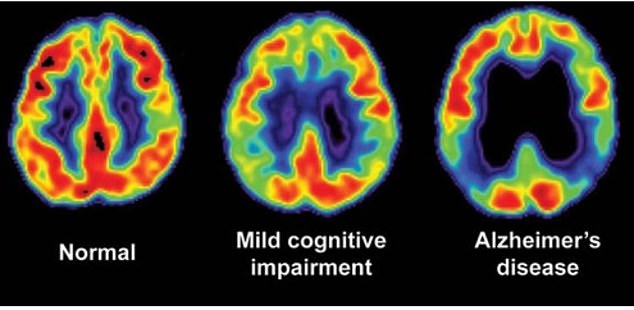Researchers intrigued by people with hallmark features of Alzheimer’s disease, but without any of the symptoms, have probed their brains in search of a cure.
They initially drew samples from the Netherlands Brain Bank, a repository of brains from more than 5,000 people who have died from a neurological disease.
They were surprised when 12 of them showed markers of Alzheimer’s disease but were still cognitively healthy.
They found that people with certain brain changes consistent with the disease showed key differences that could protect against Alzheimer’s.
Their research paves the way for more research into what exactly is behind the difference between the resilient group, as well as offering new clues for developing effective treatments.
Among thousands of donated brains sampled in the study, researchers found that 12 people had signs of Alzheimer’s disease in their brains, but no associated cognitive decline. Structural and chemical changes in the brain, such as cell death, affect a person’s level of cognitive decline.
Alzheimer’s affects approximately 47 million people worldwide and about 5.8 million in the United States.
The U.S. estimate is expected to rise in the coming years as the country’s population continues to age.
Dutch researchers identified several differences between the brains of people with Alzheimer’s but no symptoms compared to those experiencing symptoms.
Those brains with the disease but without cognitive impairment were called “resilient.”
Dr. Luuk de Vries, first author of the study, saying: “We believe that genetics and lifestyle play an important role in resilience, but the exact mechanism is still unknown.”
Their hope is that additional research will uncover specific genetic variants that can make a person more resistant to disease, which could guide researchers in developing highly specific treatments that target specific genetic mutations.
Some genetic mutations can influence certain processes, such as the production of energy to power cells.
Dr de Vries said: “If we can find the molecular basis of resilience, we will have new starting points for the development of drugs that could activate processes related to resilience in Alzheimer’s patients.”
Genes can influence the production of a protective antioxidant called metallothionein, which protects the brain from free radicals.
People with Alzheimer’s but no symptoms also had fewer immune cells that specifically target pathogens that invade the central nervous system.
These cells become overactive when certain toxic proteins called amyloid beta and tau accumulate in the brain.
This causes inflammation that can damage nerve cells and cause brain tissue to shrink, both hallmarks of Alzheimer’s.
They also noticed key differences in the way proteins folded and clustered between people involved in the study who had symptomatic Alzheimer’s versus asymptomatic people with Alzheimer’s.
The team then found evidence that resilient brains might be better at removing proteins and toxic waste that can lead to brain shrinkage.
Most Alzheimer’s treatments that have passed regulatory review, like Lequembi, target the aggregation of amyloid proteins, but so far, none of them have been shown to cause significant improvement in cognitive function.
But better understanding the chemical underpinnings of cell death that leads to cognitive decline could give drug developers and researchers a new and better way to target disease biomarkers, such as tau tangles.
Their research was published in the journal. Neuropathological Communications Act .


